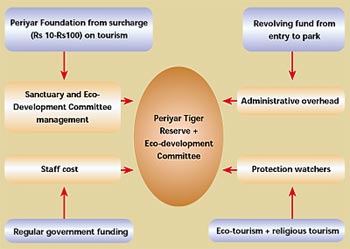The Periyar model
 Eco-development in Periyar Tiger Reserve has spun its own web of sustenance beyond the project. Its successful creation of three different types of Eco-development Committees (EDCs) has brought it to a second generation of challenges beyond the June 30, 2004 deadline for the project to end. People have a headstart here: Rs 2 crore in a community development fund collected by EDCs from their activities. The money has come from turning threats into opportunities, like the influx of nearly 5 million people to the Sabrimala shrine. Four EDCs are now allowed to manage stalls and supply shops during the pilgrimage and corner money that otherwise would have landed in the laps of outside traders.
Eco-development in Periyar Tiger Reserve has spun its own web of sustenance beyond the project. Its successful creation of three different types of Eco-development Committees (EDCs) has brought it to a second generation of challenges beyond the June 30, 2004 deadline for the project to end. People have a headstart here: Rs 2 crore in a community development fund collected by EDCs from their activities. The money has come from turning threats into opportunities, like the influx of nearly 5 million people to the Sabrimala shrine. Four EDCs are now allowed to manage stalls and supply shops during the pilgrimage and corner money that otherwise would have landed in the laps of outside traders.
With the help of the forest department, the EDCs have devised a model already being implemented. It will help pay for conservation and generate resources for regional development. The state government is supportive and has promulgated the order to set up the Periyar Foundation, a semi autonomous legal body with elected representatives, stakeholders and specialised staff to oversee the ecological and social worth of eco-development activities. It will levy a surcharge on tourists, provide assured salaries for the poachers turned protectors of Periyar's forests. Similarly, a revolving fund will help bear the administrative costs of the eco-development project.
Looks simple, yet it's the only park to have done it, out of the nine on the India Eco-Development Project roster. Why does it take the forest department large foreign loans and grants to devise plans for protected areas?
